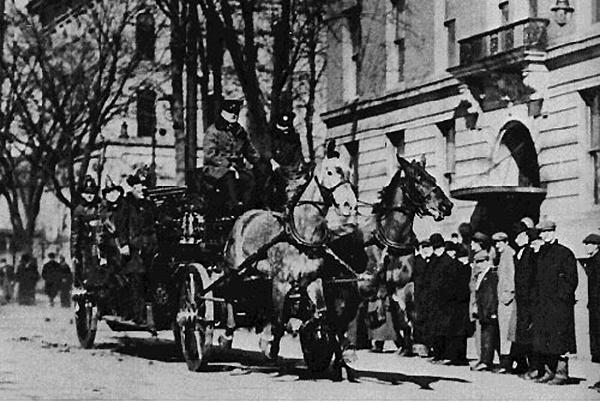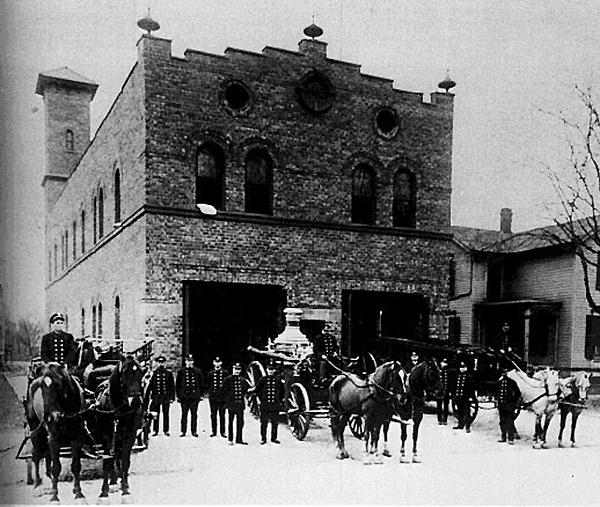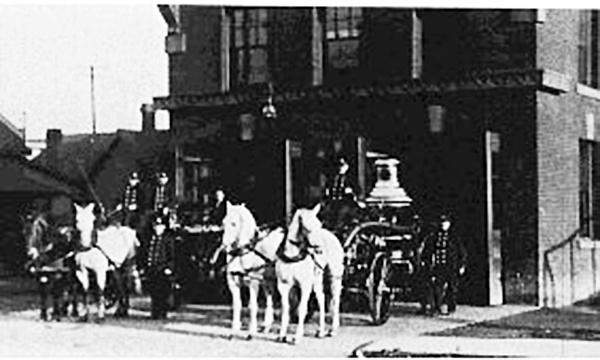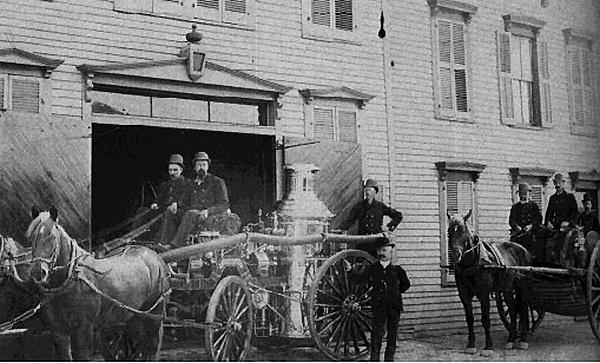The Early Years, 1837-1873, from History of the Toledo Fire Division, 1837-1977.
The earliest known action taken to form the Toledo Fire Department was on May 29, 1837. At this time, City Council selected a committee to determine the cost of two fire engines for the City of Toledo. On September 25, 1837, the firm of Hoisington and Manning was given the contract to build Engine House No. 1 and the following year to build Engine House No. 2.
In December of 1837, Council appointed the first officers and fire warden of our new department.
In the years following 1837, in mid February or early March, a Fireman’s Convention was held. Each fire company and hook and ladder company would send a certain number of delegates based on the membership of each company, and the delegates would nominate a Chief Engineer, 1st Assistant CE, and 2nd Assistant CE. These nominations were presented to council, who then appointed the officers of the fire department, usually as one of the last acts of an outgoing council. These appointments were for a one-year term. Nomination by the Fireman’s Convention was considered by the firemen as tantamount to appointment by the council. On one occasion when the council failed to appoint the nominated candidates, four fire companies subsequently disbanded in protest. (April 8, 1865)
The roll of a company, when completed, generally consisted of eighty men. Every applicant had to pass inspection for integrity and good character and be voted on by members previously enrolled. He then received a certificate of membership to the Toledo Fire Department; this certificate indicated the number of the company he was enrolled with. The officers of a company, who were usually elected at an annual meeting held during the first week of January, were a Foreman, 1st Asst. Foreman, 2nd Asst. Foreman, Secretary, and Treasurer. In the 1850s, the council provided that the men could elect officers for those who worked the fire engine as well as officers for those who worked the hose carriage. The Foreman of the engine company, however, was to have charge over the men and officers of both the engine and hose companies.
An organization known as the Teutonic Fire Guards No. 1 was formed in February, 1856 to protect the personal property at the scene of a fire.
Sometime after the first high school was built in 1854-5, a man was kept in its tower each night to ring the bell when fire broke out. The number of the ward and district were indicated by the ringing and sequence of the bells. Cards were printed giving the numbers of the different locations in the city, and each fireman carried one in his vest pocket. When the bell rang he would count the strokes and thus locate the fire from his card. The bell went down when the high school burned on March 11, 1895
The recollections of Charles O. Brigham, who in 1870 became Superintendent of the Fire Alarm Telegraph, are quite interesting regarding the volunteer department. His first connection with the department was in 1852. At that time, there was no system of water works. The fire hose was thrown into someone’s well or cistern if the fire was a distance from the Miami and Erie Canal or the Maumee River. A means of conveying water for a long distance was to station one engine at the canal and have intermediate engines pumping until the fire was reached. Mr. Brigham had known as many as four engines to be in line. From St. Clair Street back to the line of the canal, there was a swamp with water to a depth of two feet or more. In the winter, this swamp would freeze, so a hole was cut in the ice and water drawn through it.
After attaching the hose to the engine, the machine was operated at a fire by the two long handlebars (known as brakes), ten men on each side, and when one bar went up, the other came down. It was very vigorous work to pull the bar down forty times a minute, so the firemen worked in shifts. The down stroke, as with a pump handle, did the work.
In the business portion of the city, wooden cisterns were placed underground at the corners of the streets and supplied by water from the canal through maple logs with four inch holes cut through them that were placed in trenches end to end. As late as 1910, men making excavations in the streets frequently found some of these wooden water pipes to be just as sound as when they were put in the ground.
Mr. Brigham’s first capacity with Neptune No. 1 was as a torch bearer, there being four boys called to this duty for that company. Their work was to precede the company, to light the way, and to furnish light along the line of hose and for operating the engine in time of fire. From these torch bearers, in addition to twelve or more youths of the city, grew the first company organized in connection with the department. It was known as Neptune Hose Co. No. 1 and was a part of Neptune Fire Engine & Hose Co. No. 1.
 The fire engine of Neptune Fire Engine & Hose Co. No. 1
The fire engine of Neptune Fire Engine & Hose Co. No. 1
The fire engine of Neptune Fire Engine & Hose Co. No. 1 was built by James Smith of New York City. It was sold during the Civil War to the Village of Wauseon, as Neptune No. 1 had received the new Silsby steam engine. In 1935 it was donated by the Mayor and Council of the Village of Wauseon to the Toledo Relief Association. It was housed at the Toledo Zoo for years, falling into grave condition, and was finally removed and completely reconditioned by members of the Toledo Fire Division. It is now restored and kept at the No. 3 Fire Station at Bush and Erie Streets.
In those early days, the only way to spread the alarm was to cry "fire" or ring the church bells of St. Francis de Sales on Cherry Street or old Trinity Church (which was a wooden structure) on Adams Street. The alarm would bring the volunteers, as well as many citizens who were willing to help. In one fire, soldiers from Detroit on their way to the Mexican War of 1847 were forced into service and aided in forming a bucket brigade to help extinguish the fire. Great confusion sometimes existed; on occasion, the firemen would pull their machine through the mud from an engine house on Adams Street to Monroe Street, only to learn that the fire was on Cherry Street.
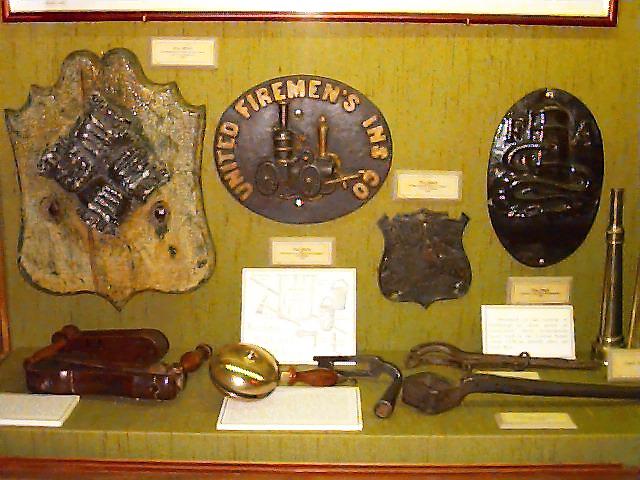 Hand rung alarms for the city ward fire marshal and a fireman's bed key for disassembling metal beds to remove them from burning buildings.
Hand rung alarms for the city ward fire marshal and a fireman's bed key for disassembling metal beds to remove them from burning buildings.
City Council, upon creating or recognizing a fire or hook & ladder company, would supply it with an engine or ladder wagon; engine house; and such apparatus as a hose carriage; hose; buckets; and ladders. Uniforms for the men were not supplied, so each year the individual companies would hold a Fireman’s Ball to raise money for such needs. These occasions were of great social importance, and the ladies and gentlemen of the city turned out in their finest apparel. Seldom was the ball of an established company unsuccessful.
The members of the individual fire companies had strong social and political ties. Neptune No. 1 was, in its early days, a strong Whig organization. Davey Crockett No. 2 and later Franklin No. 2 were for the most part Democrat and Locofoco (radical Democrats). Erin No. 2 was made up of Irishmen, as were many members of Croton No. 3, named for the Croton Aqueduct in New York State. No. 3, created by council on June 7, 1866, was an Irish Catholic temperance company. Germania No. 4 was a strong German organization, as was the Teutonic Fire Guards. Hibernia No. 5 was Irish, and No. 8 was the east side company. Independent Relief H & L Co. No. 1 was, throughout its 20 1/2 years of existence, an organization of merchants of the city.
In early June of each year, at least from the 1840s, the department held an Annual Fireman’s Parade. The members of each company would dress in a distinct uniform. The uniforms worn at the 1856 parade were noted in the Toledo Blade: Neptune No. 1 had red shirts and grey pants; Erin No. 2 reported as having only a large green banner; Croton No. 3 had white shirts and black pants; Germania No. 4 wore a black velvet uniform consisting of a helmet like that of a Prussian soldier, black velvet coat with red collar, and black pantaloons. It was noted that in case of fire the fire guards were to wear a red cloth badge with the initials F.G. on their left arm.
Every member of the fire department was expected to carry a key to the door of his engine house. Another key was hanging from the door of the engine house (the reason for this could not be found) at all times, and yet another was left in the neighborhood.
A good description of a volunteer company’s engine house appeared in the Toledo Blade of December 11, 1854: "NEW ENGINE HOUSE - Fire Co. No. 1 have their new engine house nearly completed. It stands on Cherry St., about midway from the corner of Cherry and Summit and the Canal bridge. It is built of brick, two stories high and all the exterior woodwork is covered with sheet iron. On each side of the single front window of the second story is a carved block of grey stone set in brick. On these blocks are representations of a couple trumpets crossed and ‘No. 1’ enclosed in a wreath, these chiseled in relief. This building thou’ small when finished, will be an ornament to Cherry St."
Shortly after Patrick H. Galloway joined the department as a torch boy, the burning of the Indiana House took place. It was a four story brick hotel that extended from Perry Street about half the block near Monroe Street. On the remainder of the block toward Monroe Street were frame stores. As Mr. Galloway recalled, Toledo, at this time, had the worst gang of thieves that he had ever seen in the 1800s. While the fire burned, these thieves began burglarizing, and the company of which Mr. Galloway was a member was called upon by the Chief Engineer to check the thieves at their work. The company made short work of them, driving them back and retrieving the goods they had stolen. In doing so, one of the firemen, James Burns of the fifth ward, was hit on the side of the head with a brick and suffered a broken jaw. The boarders of the hotel were robbed of their valuables, excepting those saved by the efforts of the firemen. Mr. Galloway stated in May 1900 that it was one of biggest fires in Toledo in the last century.
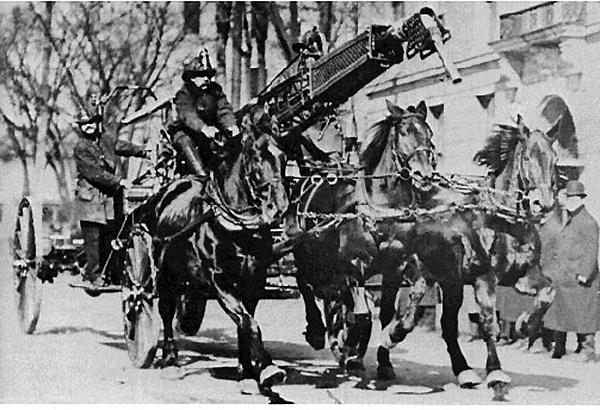 Horse Wagon
Horse Wagon
The next hottest fire in Mr. Galloway’s recollections occurred on a Sunday afternoon, when Charles A. Rowsey’s barn burned. The day was a hot one, suffocating in the extreme. Firemen were overcome by heat and were prostrated on the street. While taking a short rest some of them spat blood, but they went at the fire again. The Toledo Blade of Monday, May 14, 1855 notes the fire thusly: "FIRE The barn of Mr. C. A. Rowsey was destroyed yesterday in this city, about 4 o clock P.M. Two horses, two carriages, hay and other property were destroyed. We regret to hear that the property was not insured, and that the loss of Mr. Rowsey will amount to $1,500. The flames when discovered had proceeded too far to be arrested. It ignited from a match with which boys lighted a cigar."
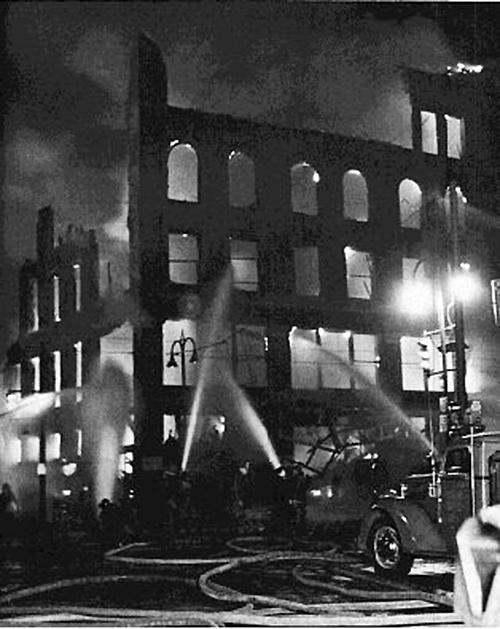 Harry Auto Stores Fire, Jan. 20, 1944.
Harry Auto Stores Fire, Jan. 20, 1944.
The burning of the houses of Judge Dunlap and Mr. Treadwell he described as roasters, as well as the "Seven Sisters Fire" on Summit Street. Mr. Galloway also recalled that the first engine house was built at the corner of Superior and Locust Sts.
At the scene of a large fire, the women of the neighborhood would set up tables of food and drink for the firemen, but the firemen paid more attention to the fire than to the refreshments. After the fire, however, the firemen (not having cleaned up) were often invited into someone’s home for refreshments, and this invitation was accepted. The next day the men of that fire company would place a ‘Card of Thanks’ in the Toledo Blade and express their gratitude for what the ladies had done.
Another interesting fact concerning the volunteer firemen was that at the time of the outbreaks of cholera in 1849 and 1853, the members of the department would turn out when a fireman had died, dig his grave, and bury him.
In November of 1872, a number of men in the city organized to assist the fire department (which was a paid department by this time except for No. 8) in pulling the steam engines to fires because the horses of the city were sick with epizooty disease.
On October 6, 1873, Toledo City Council decided by resolution to sell the first class Jefferson Hand Engine of Fire Engine & Hose Co. No. 8, thus bringing to an end the existence of the last volunteer fire company. It also ended the part paid, part volunteer Toledo Fire Department, which had existed since 1867.

